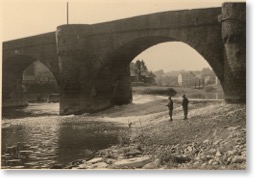
abeMeda
The File Is Out There
Genealogy and Geotagging
13 August 2009 Placed in: Related
News
In my last article about Digital Archiving I already talked
about me scanning all those shoebox-family-photos, to preserve them
and use them in some form of digital family history presentation or
family tree. But there are always lots of questions to answer along
the way.
For example — who can be seen in this photo ? When was it taken ? And where ?
Especially with ancient family photos, you’re often at a loss at this point. Not always can you find a meaningful inscription in the back, and if you weren’t there when it was taken, or immediately recognize who or where this is, identification is pretty hard. I love these kind of puzzles, whenever I find time for them — interview relatives, collect evidence, hunt for details in the pictures to give you a clue for solving the mystery.
In this case though, no relatives were left to interview or help to interpret this picture. So I started investigating on my own. The persons are small and hardly recognizable, but place and time were luckily quite easy to come by. The swastika flags in the background set the date range to 1933-1945 directly. I guessed the place to be somewhere along the smaller rivers nearby, and therefore searched the Nahe and Lahn for bridges like the one depicted.
And a little later — after some help from Google Earth - I found a medieval bridge in Runkel that looks just like the one in the picture. It is still standing today, and I could easily reconstruct the actual place of the camera and the viewing angle — and tagged that as geotag to the picture with CDWinder.
The person with the fishing-rod is presumably my grandfather, but I could not identify his younger companion yet.
With pictures like these, and Google Earth, I can delve right into the past by just imagining where and how a photo was taken, and how the place must have looked like back then. I like to spend the odd rainy afternoon or cold winter evening with this kind of detective work, to puzzle my ancestors history back together bit by bit, to document it and perhaps someday pass it on. The KMZ-Export in CDWinder for example was developed with something like this in mind.
For example — who can be seen in this photo ? When was it taken ? And where ?
Especially with ancient family photos, you’re often at a loss at this point. Not always can you find a meaningful inscription in the back, and if you weren’t there when it was taken, or immediately recognize who or where this is, identification is pretty hard. I love these kind of puzzles, whenever I find time for them — interview relatives, collect evidence, hunt for details in the pictures to give you a clue for solving the mystery.
In this case though, no relatives were left to interview or help to interpret this picture. So I started investigating on my own. The persons are small and hardly recognizable, but place and time were luckily quite easy to come by. The swastika flags in the background set the date range to 1933-1945 directly. I guessed the place to be somewhere along the smaller rivers nearby, and therefore searched the Nahe and Lahn for bridges like the one depicted.
And a little later — after some help from Google Earth - I found a medieval bridge in Runkel that looks just like the one in the picture. It is still standing today, and I could easily reconstruct the actual place of the camera and the viewing angle — and tagged that as geotag to the picture with CDWinder.
The person with the fishing-rod is presumably my grandfather, but I could not identify his younger companion yet.
With pictures like these, and Google Earth, I can delve right into the past by just imagining where and how a photo was taken, and how the place must have looked like back then. I like to spend the odd rainy afternoon or cold winter evening with this kind of detective work, to puzzle my ancestors history back together bit by bit, to document it and perhaps someday pass it on. The KMZ-Export in CDWinder for example was developed with something like this in mind.






